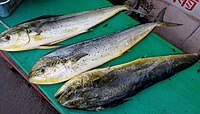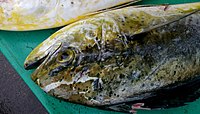Mahi-mahi
| Mahi-mahi | |
|---|---|

| |
| Scientific classification | |
| Domain: | Eukaryota |
| Kingdom: | Animalia |
| Phylum: | Chordata |
| Class: | Actinopterygii |
| Order: | Carangiformes |
| Family: | Coryphaenidae |
| Genus: | Coryphaena |
| Species: | C. hippurus
|
| Binomial name | |
| Coryphaena hippurus | |
| Synonyms[2] | |
| |

Themahi-mahi(/ˈmɑːhiːˈmɑːhiː/)[3]orcommon dolphinfish[2](Coryphaena hippurus) is a surface-dwellingray-finned fishfound in off-shoretemperate,tropical,andsubtropicalwaters worldwide. Also widely calleddorado(not to be confused withSalminus brasiliensis,a freshwater fish) anddolphin,it is one of two members of the familyCoryphaenidae,the other being thepompano dolphinfish.These fish are most commonly found in the waters around theGulf of Mexico,Costa Rica,Hawaiiand theIndian Ocean.
Nomenclature
[edit]The namemahi-mahicomes from theHawaiian language[4]and means 'very strong', through the process ofreduplication.[5]By chance inPersian,mahi(ماهی) means 'fish', but the wordmahi-mahiis Hawaiian. Though the species is also referred to as the common dolphinfish, the use ofdolphincan be misleading as they are not related todolphins;seeCoryphaenafor the possibleetymologiesofdolphinfish.In parts of the Pacific and along the English-speaking coast ofSouth Africa,the mahi-mahi is commonly referred to by its name inSpanish,dorado.[6]On theMediterraneanisland ofMalta,the mahi-mahi isreferred toas thelampuka.InIndonesian,they are calledikan lemadang.
Linnaeusnamed the genus, derived from the Greek word,κορυφή,koryphe,meaning 'top' or 'apex', in 1758. Synonyms for the species includeCoryphaena argyrurus,Coryphaena chrysurus,andCoryphaena dolfyn.[2]
Description
[edit]Mahi-mahi havecompressed bodiesand one very longdorsal finextending from the head almost to the tail fin.Maturemales have distinctive "foreheads";it grows as the fish matures and often protrudes well above the body proper, which isstreamlinedby the musculature of the back. This "hump"is asexually dimorphicfeature; females have a rounded head. Their caudal fins andanal finsare sharplyconcave.They are distinguished by dazzling colors –goldenon the sides, and bright blues and greens on thesidesand back. The pectoral fins of the mahi-mahi areiridescentblue. The flank is broad and golden.[7] Out of the water, the fish often change color (giving rise to theirSpanishname,dorado,'golden'), going through several hues before finally fading to a muted yellow-grey upondeath.
Mahi-mahi canlive for up tofive years, although they seldom exceed four. Females are usually smaller than males. Catches typically are 7 to 13 kg (15 to 29 lb) and a meter in length. They rarely exceed 15 kg (33 lb), and mahi-mahi over 18 kg (40 lb) are exceptional. Mahi-mahi are among thefastest-growingof fish. They spawn in warm ocean currents throughout much of the year, and their young are commonly found in rafts ofSargassumweeds. Young mahi-mahimigratepastMaltawhere they are calledlampukiandSicilywhere they are known aslampugaorcapone;there they are fished using nets andfloating mats of palm leavesunder which they collect.
Mahi-mahi arecarnivorous,feeding onflying fish,crabs,squid,mackerel,and otherforage fish.They have also been known to eatzooplankton.Topursuesuch variedpelagic prey,mahi-mahi are fast swimmers, swimming as fast as 50knots(92.6 km/h, 57.5 mph).[citation needed]
Males and females aresexually maturein their first year, usually by the age of 4–5 months.Spawningcan occur at body lengths of 20 cm (7.9 in). Females may spawn two to three times per year, and produce between 80,000 and 1,000,000 eggs per event. In waters at 28 °C/83 °F, mahi-mahi larvae are found year-round, with greater numbers detected in spring and fall.[8] Mahi-mahi fish are mostly found in thesurface water.Theirfleshis grey-white when raw, cooking to an attractive white with a clean,non-fishyflavour.
-
Mahi-mahi in afish market
-
Closeup
Relation to humans
[edit]Fishing
[edit]Recreational fishing
[edit]Mahi-mahi are highly sought for sport fishing and commercial purposes. Sport fishermen seek them due to their beauty, size, food quality, and healthy population. Mahi-mahi can be found in theCaribbean Sea,on the west coast of North and South America, the Pacific coast ofCosta Rica,theGulf of Mexico,theAtlanticcoast ofFloridaandWest Africa,Indian Ocean,Bay of Bengal,South China SeaandSoutheast Asia,Hawaii,Tahiti,and many other places worldwide.
Fishing charters most often look for floating debris andfrigatebirdsnear the edge of the reef in about 120 feet (37 m) of water. Mahi-mahi (and many other fish) often swim near debris such as floating wood, five-gallon bucket lids, palm trees and fronds, or sargasso weed lines and aroundfish buoys.Frigatebirds search for food accompanying the debris or sargasso. Experienced fishing guides can tell what species are likely around the debris by the birds' behavior.
30-to-50-pound (14 to 23 kg) gear is more than adequate whentrollingfor mahi-mahi. Fly-casters may especially seek frigatebirds to find big mahi-mahis, and then use a bait-and-switch technique.Ballyhooor a net full of livesardinestossed into the water can excite the mahi-mahis into a feeding frenzy. Hookless teaser lures can have the same effect. After tossing the teasers or livechum,fishermen throw the fly to the feeding mahi-mahi. Once on a line, mahi-mahi are fast, flashy, and acrobatic, with beautiful blue, yellow, green, and even red dots of color.
Commercial fishing
[edit]The United States and the Caribbean countries are the primary consumers of this fish, but many European countries are increasing their consumption every year.[citation needed]It is a popular food fish in Australia, usually caught and sold as a byproduct by tuna and swordfishcommercial fishingoperators. Japan and Hawaii are significant consumers. TheArabian Sea,particularly the coast ofOman,also has mahi-mahi. At first, mahi-mahi were mostlybycatchin the tuna and swordfishlonglinefishery. Now, they are sought by commercial fishermen on their own merits.
InFrench Polynesia,fishermen useharpoons,using a specifically designed boat, thepoti marara,to pursue it, because mahi-mahi do not dive. Thepoti mararais a powerful motorized V-shaped boat, optimized for high agility and speed, and driven with a stick so the pilot can hold his harpoon with his right hand. The method is also practiced by fishermen in the Philippines, especially in the northern province of Batanes, where the harpooning is calledpagmamamataw.
Environmental and food safety concerns
[edit]Depending on how it is caught, mahi-mahi is classed differently by various sustainability rating systems:
- TheMonterey Bay Aquariumclassifies mahi-mahi, when caught in the US Atlantic, as a best choice, the top of its three environmental-impact categories. The aquarium advises to avoid imported mahi-mahi harvested by long line, but rates troll and pole-and-line caught as a good alternative.
- TheNatural Resources Defense Councilclassifies mahi-mahi as a "moderatemercury"fish (its second-lowest of four categories), and suggests eating six servings or fewer per month.[9]
The mahi-mahi is also a common vector forciguatera poisoning.[10]Although a very popular food dish in many parts of the world, there have been reports of ciguatera poisoning from human consumption of this fish. Ciguatera poisoning is caused by the accumulation of toxins (ciguatoxinsandmaitotoxin) in the flesh of the fish over time. These are produced byGambierdiscus toxicuswhich grows together with marine algae, which causes fish like the mahi-mahi to consume them by accident.[11]
Mahi-mahi naturally have high levels ofhistidine,which is converted tohistaminewhenbacterialgrowth occurs during improper storage or processing.[12]Subsequent cooking, smoking, or freezing does not eliminate the histamine. This leads to afoodborne illnessknown asscombroid food poisoning,which also affect other fish such astuna,mackerel,sardine,anchovy,herring,bluefish,amberjackandmarlin.[12]Symptoms are those ofhistamine intoleranceand may includeflushed skin,headache, itchiness, blurred vision, abdominal cramps, and diarrhea,[12]and the onset of symptoms is typically 10 to 60 minutes after eating and can last for up to two days.[12]Rarely, breathing problems (like that ofallergic asthma) or anirregular heartbeatmay occur.[12]Diagnosis is typically based on the symptoms and may be supported by a normal bloodtryptase.[13]
-
Bull (male) mahi-mahi
-
Mahi-mahi are attracted toSargassum,floating brown algae that serve as both a hiding place and source of food. Lines of this genus can stretch for miles along the ocean surface.
-
Grilledmahi-mahi
References
[edit]- ^Collette, B.; Acero, A.; Amorim, A.F.; Boustany, A.; Canales Ramirez, C.; Cardenas, G.; Carpenter, K.E.; de Oliveira Leite Jr.; N.; Di Natale, A.; Fox, W.; Fredou, F.L.; Graves, J.; Viera Hazin, F.H.; Juan Jorda, M.; Minte Vera, C.; Miyabe, N.; Montano Cruz, R.; Nelson, R.; Oxenford, H.; Schaefer, K.; Serra, R.; Sun, C.; Teixeira Lessa, R.P.; Pires Ferreira Travassos, P.E.; Uozumi, Y.; Yanez, E. (2011)."Coryphaena hippurus".IUCN Red List of Threatened Species.2011:e.T154712A4614989.doi:10.2305/IUCN.UK.2011-2.RLTS.T154712A4614989.en.Retrieved19 November2021.
- ^abcFroese, Rainer; Pauly, Daniel (eds.) (2019)."Coryphaena hippurus"inFishBase.August 2019 version.
- ^"Dictionary.com: define Mahi-mahi".
- ^Mary Kawena Pukui;Samuel Hoyt Elbert(2003)."lookup ofdolphin".in Hawaiian Dictionary.Ulukau, the Hawaiian Electronic Library,University of Hawaii Press.
- ^"mahimahi".Te Aka Māori Dictionary.Retrieved2022-09-02.
- ^"Fish detail".WWF SASSI.Retrieved2018-05-31.
- ^Dianne J. Bray, 2011, Mahi Mahi, Coryphaena hippurus, in Fishes of Australia, accessed 07 Oct 2014,http://www.fishesofaustralia.net.au/home/species/1730
- ^Bostwick, Joshua (2000)."Coryphaena hippurus".Animal Diversity Web.RetrievedAugust 17,2011.
- ^"Consumer Guide to Mercury in Fish".
- ^"Ciguatera Fish Poisoning (CFP)".Fish and Wildlife Research Institute. Archived fromthe originalon 2006-11-25.Retrieved2010-01-04.
- ^"Dolphinfish".Florida Museum of Natural History. 2019.RetrievedJune 2,2019.
- ^abcde"Food Poisoning from Marine Toxins - Chapter 2 - 2018 Yellow Book".CDC.2017.Retrieved1 June2018.
 This article incorporates text from this source, which is in thepublic domain.
This article incorporates text from this source, which is in thepublic domain.
- ^Ridolo, E; Martignago, I; Senna, G; Ricci, G (October 2016). "Scombroid syndrome: it seems to be fish allergy but... it isn't".Current Opinion in Allergy and Clinical Immunology.16(5): 516–21.doi:10.1097/ACI.0000000000000297.PMID27466827.S2CID21610715.
External links
[edit]- Froese, Rainer; Pauly, Daniel (eds.) (2004)."Coryphaena hippurus"inFishBase.October 2004 version.
- DolphinfishMonterey Bay Aquarium
- Oceana's Sustainable Seafood Guide
- DolphinfishFlorida Museum
- Dolphinfishesfrom iNaturalist
- Atlantic Mahi MahiNOAA FishWatch.Retrieved 11 November 2012.
- Pacific Mahi MahiNOAA FishWatch.Retrieved 11 November 2012.








